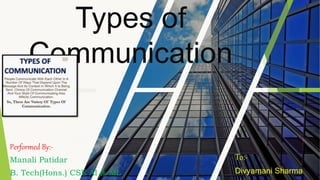
Types of communication manali patidar
- 1. Types of Communication Performed By:- Manali Patidar B. Tech(Hons.) CSE AI & ML To:- Divyamani Sharma
- 2. What is communication ? The word communication has originated from a Latin word “Communes” which means something common. ➣Communication is a process of exchanging information, ideas, thoughts, feeling and emotions through speech signals, writing or behavior. In communication process, a sender encodes a message and then using a medium and send it to appropriate feedback using a medium.
- 3. 3 Express thoughts, ideas and feelings Creating awareness To fulfil a goal Avoid isolated Highlight issues Progress, development Educating the masses etc. 1 IMPORTANCE OF COMMUNICATION
- 6. Non-verbal communication Nonverbal communication (NVC) is the transmission of messages or signals through a nonverbal platform such as eye contact, facial expressions, gestures, posture, and the distance between two individuals. It includes the use of visual cues such as body language (kinesics), distance (proxemics) and physical environments/appearance, of voice (paralanguage) and of touch (haptics).[1] It can also include the use of time (chronemics) and eye contact and the actions of looking while talking and listening, frequency of glances, patterns of fixation, pupil dilation, and blink rate.
- 7. Types of Non-verbal communication KINESICS (BODY LANGUAGE) HAPTICS (TOUCH LANGUAGE) PROXEMICS ,(SPACE LANGUAGE) ARTIFACTS ENVIRONMENTAL CHRONEMICS (TIME LANGUAGE) SILENCE SIGN PARALANGUAGEVOCALIC
- 8. 8 FACIAL EXPRESSIONS A facial expression is one or more motions or positions of the muscles beneath the skin of the face. According to one set of controversial theories, these movements convey the emotional state of an individual to observers. Facial expressions are a form of nonverbal communication.
- 9. HEAD If someone move hisher head up & down it means heshe is agree with you or saying yes and it also means understanding and acknowledgement. Sideways movement of head means no or not understood. If a person bring his head down and looking his feet or earth it is the symbol of humility & modesty.
- 10. EYE GAZE Looking at another person can indicate a range of emotions like anger, grudge and danger, a dangerous look can tell you someone is unhappy and not comfortable with
- 13. Proxemics (Space language) ➼To communicate while keeping a distance is called Proxemics. ➼The amount of distance we need and the amount of space we perceive as belonging to us is influenced by a number of factors including social norms, situational factors, personality characteristics and level of Familiarity.
- 14. 14 INTRAPERSONAL COMMUNICATION Intrapersonal communication can be defined as communication with one's self, and that may include self-talk, acts of imagination and visualization, and even recall and memory. Two people communicating means interpersonal. This is in contrast to intrapersonal communication which is only done within one's own mind with one's own thoughts, feelings, and ideas.
- 15. 15 FORMAL COMMUNICATIONS Formal communication refers to interchange of information officially. The flow of communication is controlled and is a deliberate effort. This makes it possible for the information to reach the desired place without any hindrance, at a little cost and in a proper way. This is also known as ‘Through Proper Channel Communication.’
- 16. 16 upward communication Upward communication is the process by which lower-level company employees can directly communicate with upper management to provide feedback, complaints or suggestions regarding the day- to-day operations of the company.
- 17. 17 DOWNWARD COMMUNICATIONS Downward communication is the communication where information or messages flows from the top of the organizational structure from the bottom of the organizational structure. Downward communication occurs when information flows down the hierarch form superiors to subordinates.
- 18. HORIZANTAL COMMUNICATION Horizontal communication is the communication that flows laterally within the organization, involves persons at the same level of the organization. Horizontal communication normally involves coordinating information and allows people with the same or similar rank in an organization to cooperate or collaborate.
- 19. DIAGONAL COMMUNICATION Diagonal communication is cross- functional communicatio n between employees at different levels of the organization. Building relationships between senior-level and lower- level employees from different parts of the organization.
- 20. INFORMAL COMMUNICATION The Informal Communication is the casual and unofficial form of communication wherein the information is exchanged spontaneously between two or more persons without conforming the prescribed official rules, processes, system, formalities and chain of command.
- 21. MASS COMMUNICATION Mass communication is the process of imparting and exchanging information through mass media to large segments of the population. It is usually understood for relating to various forms of media, as these technologies are used for the dissemination of information, of which journalism and advertising are part.
- 22. THANK YOU!